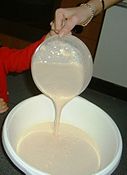Batter (cooking)

Batter is a flour mixture with liquid and other ingredients such as sugar, salt, and leavening used for cooking. It usually contains more liquid than dough, which is also a mixture of flour and liquid. Batters are usually a pourable consistency that cannot be kneaded.[1] The batter is most often used for pancakes, light cakes, and as a coating for fried foods. It is also used for a variety of batter breads.
The word batter comes from the French word battre, which means to beat,[2] as many batters require vigorous beating or whisking in their preparation.
Methods
Many batters are made by combining dry
The
-
Crêpe batter
-
Batter with a batter spoon
-
Close-up view of angel food cake batter
Beer batter

Beer is a popular ingredient in batters used to coat foods before frying. One reason is that a basic batter can be made from merely flour, beer, and some salt. The purpose of using beer is so the bubbles in the beer will add body and lightness to the batter.
Cuisine and batters
Batters are used in many cuisines under many names.
Batters made with wheat flour thicken with every second that passes after mixing because of the development of gluten. Strategies to reduce this effect include the use of ice water when mixing, alcohol (which does not mix with the flour to produce gluten), and making it at the last possible moment before use.[6]
References
- ISBN 978-0-684-80001-1.
- ^ www.askoxford.com. "AskOxford.com". AskOxford.com. Archived from the original on 19 October 2004. Retrieved 16 March 2009.
- .
- S2CID 33678259.
- ^ The Oxford Companion to Food (2nd Edition), Alan Davidson, Oxford University Press, 2006)
- ^ The Science of Good Cooking, America's Test Kitchen, 2012
External links
 Media related to Batter (cooking) at Wikimedia Commons
Media related to Batter (cooking) at Wikimedia Commons



